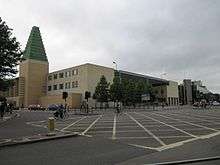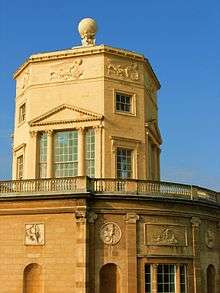Saïd Business School
Coordinates: 51°45′40″N 1°15′12″W / 51.7611°N 1.2534°W
 | |
| Established | Centre for Management Studies 1965, re-branded 1996 [1] |
|---|---|
| Dean | Peter Tufano |
Academic staff | 90 |
| Undergraduates | 300 |
| Postgraduates |
340 MBA 240 EMBA 80 MFE 50 MLF |
| 50 | |
| Location | Oxford, United Kingdom |
| Affiliations | University of Oxford |
| Website | www.sbs.ox.ac.uk |
 | |
Saïd Business School (Oxford Saïd) is the business school of the University of Oxford.[2][3][4] It is part of Oxford's Social Sciences Division.
Oxford Saïd is the University of Oxford's centre of learning for undergraduate and graduate students in business, management and finance. With over 500 matriculated graduate students entering each year, it has the largest intake of all graduate business schools in the UK. Undergraduates are also taught as part of the Economics and Management course together with the Economics Department.
While business and management courses have been taught at Oxford since 1965, the school of management was re-branded as Saïd Business School in 1996.[5][6] It is named after its chief benefactor Wafic Saïd, a Syrian-Saudi Arabian billionaire arms dealer, financier, businessman and philanthropist, who has donated £70 million to date.[7] The current dean is Peter Tufano, who was formerly on the faculty of the Harvard Business School for 22 years.
History
The Oxford Centre for Management Studies (OCMS) was founded in 1965; the OMCS was the precursor to both what is now Saïd Business School and to Templeton College, the University's business-focused postgraduate college. Templeton College was named after Sir John Templeton, an American-born Rhodes Scholar and billionaire mutual fund pioneer, who made a significant donation to the college. Initially, OCMS was an "associate institution" of the University, providing executive, graduate and later undergraduate courses in Management Studies. OCMS was renamed Templeton College in 1983, and the University of Oxford School of Management Studies was created in 1991, taking over the undergraduate and graduate degree courses from the college.[8] Saïd Business School was formed in 1996 out of the School of Management Studies.
The new business school building was completed in 2001 with a £28 million benefaction from Wafic Saïd.[9] The building includes an amphitheatre and the Sainsbury Library, and was designed by Edward Jones and Sir Jeremy Dixon. It was built on the site of Oxford Rewley Road railway station. The opening on 5 November 2001 was accompanied by a demonstration by students mainly because of the controversial nature of Wafic Saïd's donation. (Saïd was associated with the UK's signing of the Al-Yamamah arms deal.)[10]
Degree programmes

Saïd Business School's main degree programmes are its one-year full-time MBA programme, 21-month modular Executive MBA programme, the DPhil or PhD Programme in Management Studies, the MSc in Financial Economics in cooperation with the Economics Department and the one-year MSc in Law and Finance (MLF) in conjunction with the Oxford Law Faculty.
Undergraduate programme
Oxford Saïd offers one undergraduate programme: Bachelor of Arts in Economics and Management. This programme is taught jointly by the Department of Economics and the Business School.
Graduate programmes

MBA
Saïd Business School offers a one-year full-time Master of Business Administration degree, which enrolls approximately 320 students per year. In the 2018–2019 class of 317 students, 61% of were male and 39% were female[11] with 62 nationalities represented and averaged 5 years of work experience.
The School revamped the MBA programme for the 2014/15 academic year[12] to focus more heavily on three main themes:
- Entrepreneurship
- Global rules of the game
- Responsible leadership
The academic calendar consists of three terms each lasting ten weeks. The first eight weeks are used for lectures. The ninth week is the study week and the tenth week is the exam week. The one-year programme will be extended in 2014/15 to allow for the additional workload. Each of the three terms will be two weeks longer and there will be three extra weeks of pre-course work at the beginning.[12]
EMBA
Saïd Business School also offers a 21-month part-time 'Executive Master of Business Administration' degree designed for people with more than 5 years’ management experience. The Oxford EMBA is studied through 16 week-long modules largely taught in Oxford, but with at least two conducted in key international markets. As of 2016, the programme runs two iterations per year, with new cohorts starting in both January and September. There are 60 students in September 2016 class, from 21 different nationalities and 28% of which are women. There are several scholarships for women available each year for outstanding candidates.[13]
1+1 MBA
Dean Peter Tufano started the Oxford 1+1 MBA programme which allows students to pair the one-year full-time MBA programme with one of a selection of one-year MSc programmes offered by other University of Oxford departments. For example, students can acquire an MBA in conjunction with a MSc from the Department of Computer Science or the Department of Education. The idea behind the Oxford 1+1 programme is to combine the depth of a specialised, one-year master's degree with the breadth of a one-year MBA.[14]
Diplomas in Strategic Management
Oxford Saïd also offers four 13-month Masters-level Diplomas in Strategic Management. Each post-graduate Diploma programme offers senior executives a strategic overview of a specialized area of management: Financial Strategy, Strategy & Innovation, Organisational Leadership, and Global Business.
MSc in Major Programme Management
The School runs an MSc in Major Programme Management in association with the BT Centre for Major Programme Management. It also offers two MEng programmes and the top ranked BA in Economics and Management.[15]
DPhil in Management Studies
The Oxford DPhil (PhD) Programme prepares students for academic and professional careers within the fields of financial economics, finance and management. The programme offers the opportunity to engage with internationally renowned faculty and provides access to specialist research centres and innovative facilities.
The structure of the DPhil programme largely depends on what subject area students chose to specialise. There are two pathways students can follow: financial economics, which focuses on asset pricing and corporate finance, or management research, which focuses on quantitative and qualitative research methodology.[16]
Academic performance
| Business school rankings | |
|---|---|
| Worldwide overall | |
| QS[17] | 8 |
| Times Higher Education[18] | 3 |
| Worldwide MBA | |
| Business Insider[19] | 26 |
| Economist[20] | 83 |
| Financial Times[21] | 28 |
Despite its relatively young age, Oxford Saïd has established itself as a highly ranked business school. in the 2013/2014 QS Global 200 Business Schools Report, Saïd placed fourth in the European part of the ranking.[22]
In 2016, the full-time MBA programme ranked 28th in the world and 3rd in the UK in the Financial Times Ranking[23] In 2013, the full-time MBA programme ranked 7th in Business Week’s international business schools rankings[24] and 6th in Forbes' Best International MBA Programs rankings.[25]
The MSc in Financial Economics programme ranked 6th in the world and 1st in the UK in the Financial Times ranking of Pre-experience Masters Programmes in 2013.[26]
In both 2015 and 2016, the Executive MBA programme ranked 9th in the Financial Times’ Global EMBA ranking,[27] and 2nd in the Economist's Executive MBA ranking.[28]
In Executive Education, Oxford Saïd was ranked 4th worldwide in the table for open enrolment executive programmes and 26th in the table for custom programmes by the Financial Times in 2017.[29]
Admissions

Admission to Saïd Business School is competitive. The average GMAT score in 2013–2014 for the MBA programme was 692,[30] while the average GMAT score in 2013–2014 for the MFE programme was 734.[31]
Relationship to the University
Saïd Business School is an academic department of the University of Oxford and cooperates closely with several other departments such as the Economics Department and the Faculty of Law. All Oxford Saïd students are members of one of the constituent colleges of the University of Oxford. A large part of Saïd's students find accommodation through their colleges and being member of a college provides an opportunity to meet fellow students from all departments of the university.
The following colleges accept MBA students: Balliol College, Brasenose College, Christ Church, Exeter College, Green Templeton College, Harris Manchester College, Hertford College, Jesus College, Keble College, Kellogg College, Lady Margaret Hall, Linacre College, Lincoln College, Mansfield College, Merton College, New College, Oriel College, Pembroke College, Regent's Park College, Somerville College, St. Anne's College, St. Catherine's College, St. Cross College, St. Edmund Hall, St. Hilda's College, St. Hugh's College, St. John's College, St. Peter's College, Queen's College, Trinity College, Wadham College, Wolfson College, Worcester College
Notable alumni
- Patrick Grant (MBA) – British fashion designer
- Claire Diaz Ortiz (MBA) – Social Innovation at Twitter, Fast Company's 100 Most Creative People in Business
- Javed Afridi (PhD) Chief Executive Officer (CEO) of Haier Pakistan
- Stephen Robert Morse (MBA) Journalist and Film Director/Producer
- Cameron Winklevoss (MBA) – USA Olympic Rower and Internet Entrepreneur
- Tyler Winklevoss (MBA) – USA Olympic Rower and Internet Entrepreneur
- Bradley Henderson (MBA) – Rhodes Scholar, Boston Consulting Group
- Caryn Davies (MBA) – USA Olympic Rower
- Tim Foster (EMBA) – British Rower
- Colin Smith (MBA) – British Olympic Rower
- George Bridgewater (MBA) – New Zealand Olympic rower
- Storm Uru (MBA) – New Zealand Olympic rower
- Ante Kušurin – Croatian Olympic Rower
- Kenges Rakishev – Kazakhstan Investor
- Elizabeth Filippouli – Broadcaster, Entrepreneur and Global Business Strategist
- Toshiharu Furukawa (MBA) – Japanese Politician, Professor at Keio University
- Papa CJ (MBA) – Indian Comedian
- James L. Hall II (MBA) – Insurance Executive
- Mohamed Amersi (EMBA) - British businessman and philanthropist
- Shawn Baldwin (MFS) - American Investor
- Faisal Butt (MBA) - British Investor and Entrepreneur
- Ruthe Farmer (MBA) - American policymaker and activist
- Þorsteinn B. Friðriksson (MBA) - Icelandic Mobile App Entrepreneur
- Gustavo Gonzalez (Postgraduate Diploma) - UN Official
- Jane Silber (MBA) - American businesswoman and Computer Scientist
Faculty
See also
References
- ↑ "A Brief History of the University". University of Oxford. Retrieved 30 October 2007.
- ↑ "Global MBA Ranking 2017". Rankings Financial Times. 2017.
- ↑ "University of Oxford – Saïd Business School". Find-mba. 2017.
- ↑ "Saïd Business School". Top Universities. 2017.
- ↑ "Said Business School, University of Oxford". Mastersportal. 2017.
- ↑ "University of Oxford – Saïd Business School". Economist. 2017.
- ↑ "Said Business School—Our Benefactors". Archived from the original on 28 April 2012. Retrieved 10 April 2018.
- ↑ "A Bit of History". Templeton College, Oxford. Archived from the original on 7 October 2006. Retrieved 15 April 2018.
- ↑ "Saïd Business School". Said Foundation. 2017.
- ↑ Jarvis, Paul; Norwood, Tamarin. "Protest on business school". The Oxford Student. Archived from the original on 2005-04-16. Retrieved 2018-04-15.
- ↑ "2018–19 MBA class profile". University of Oxford. Retrieved 23 September 2018.
- 1 2 "Oxford MBA to focus on global issues and effective leadership". www.ft.com. Retrieved 29 July 2014.
- ↑ "Oxford Executive MBA - Said Business School". www.sbs.ox.ac.uk. Retrieved 10 April 2018.
- ↑ "Saïd Business School". Top MBA. 2017.
- ↑ "University guide 2010: Business and management studies". the Guardian. 12 May 2009. Retrieved 10 April 2018.
- ↑ "Doctoral programme outline - Saïd Business School". www.sbs.ox.ac.uk. Retrieved 10 April 2018.
- ↑ "QS World University Rankings by Subject 2017 - Business & Management Studies". Quacquarelli Symonds. 2017. Retrieved 2017-03-15.
- ↑ "World University Rankings by subject: business and economics". Times Higher Education. 2016. Retrieved 2016-10-29.
- ↑ "The 50 best business schools in the world". Business Insider. 2015. Retrieved 2016-02-06.
- ↑ "Full time MBA ranking". Economist. 2016. Retrieved 2017-03-15.
- ↑ "Global MBA Ranking". Financial Times. 2017. Retrieved 2017-01-31.
- ↑ Europe – TopMBA Global 200 Business Schools Report 2013/2014, Retrieved 2 August 2014.
- ↑ Financial Times Global MBA Ranking 2016, Retrieved 24 January 2016.
- ↑ Businessweek Best International Business School Rankings 2013, Retrieved 26 October 2013.
- ↑ "Forbes Best International MBA Programs 2013". Archived from the original on 9 October 2013. Retrieved 17 April 2018.
- ↑ Financial Times, Master's in Finance 2013, Retrieved 26 October 2013.
- ↑ EMBA Rankings 2016, Retrieved 1 November 2016.
- ↑ The Economist, Executive MBA Rankings 2015, Retrieved 1 November 2016.
- ↑ Financial Times, Executive Education Rankings 2017, Retrieved 15 August 2017.
- ↑ "2013–14 MBA class profile". University of Oxford. Retrieved 29 July 2014.
- ↑ "2013–14 MFE class profile". University of Oxford. Retrieved 29 July 2014.
External links
- Official website of Saïd Business School
- Oxford Business Alumni
- "Brash addition to Oxford's spires" — The Times Online at Archive.is (archived 8 February 2007)
- "The Top Non-US One-Year Business School 2010" at Archive.is (archived 23 January 2013)
